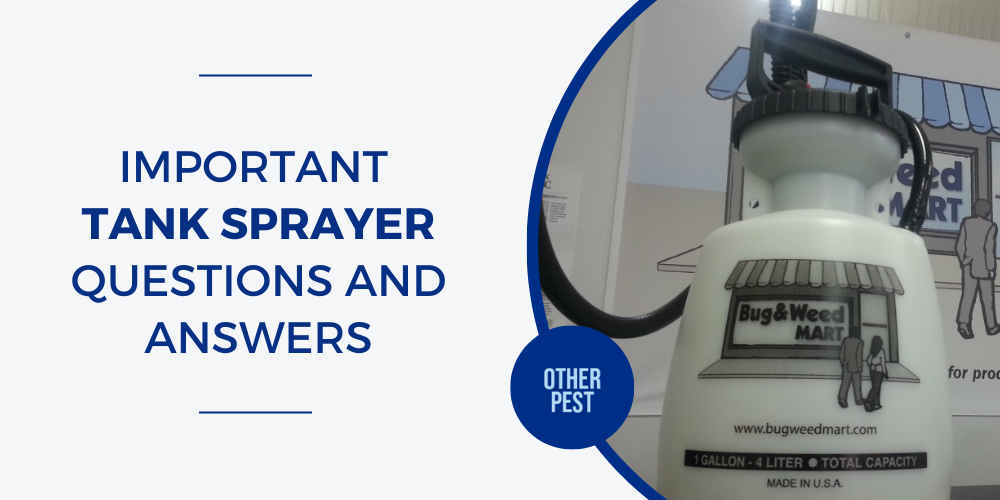Having the right tools is crucial for any DIY enthusiast – especially when it comes to pest and weed control. Keeping pests and weeds at bay can be easy with the right tools. One of the most valuable tools used for DIY pest control is a pump-up tank sprayer, which is the piece of equipment necessary for applying most pest and weed control products. Before grabbing a tank sprayer and tackling pest or weed prevention, we recommend getting answers to the following questions: What kind of tank sprayer do I need? How do I use it? What is the maintenance for a tank sprayer? Fortunately, you’re in luck, our Bug & Weed Mart experts have all the answers to these important tank sprayer questions.
Choosing a tank sprayer
The first question to ask is what kind of sprayer should I buy? Since opening in 1979, Bug & Weed Mart has sold more than 35,000 tank sprayers – so we know what we are talking about. We carry a variety of B & G Equipment sprayers to address different needs. When deciding which tank sprayer will be the best fit, there are a few key factors to consider:
Tank size
Tank bodies come in a variety of sizes and it’s important to choose the appropriate size in relation to the projects it will be used for. A body or tank that’s too big is wasteful, and a body that’s too small becomes frustrating when tackling larger areas. Tank bodies can range from 1 – 25 gallons. If you’re unsure what size is best for your needs, an experienced Bug & Weed Mart team member can help you choose based on your property size and the types of tasks it will be used for.
Hose features
Hose quality is an important detail to consider when picking out a tank sprayer. Hoses need to be long enough to reach difficult spaces, and they also need to be sturdy. A hose won’t last very long if it feels thin or flimsy when pinched.
Wand type
Tank sprayer wands can be made from a variety of materials, but the best ones are made from brass. Wands made from plastic and similar materials will wear out sooner, costing more down the road when it needs to be replaced.
Spray nozzle
Spray nozzles that emit a coarse mist can waste product and tend to drip, making them less efficient. The best choice is a supplemental fan spray tip. Second, is a fine mist tip. The fan spray tips and the fine mist tip provide more precise applications and reduce the chances of wasting solution.
How to properly use a tank sprayer
Once you’ve purchased the right tank sprayer, you need to know how to use it. The key to a long-lasting sprayer is understanding how to properly use and care for it. Here are seven simple steps to using a tank sprayer and making it last:
- Fill the sprayer no higher than the max-fill line with the bug or weed solution recommended.
- Pump the plunger tube until resistance from the pressurization is felt. Make sure not to over-pump and gain too much pressure. Over-pumping your sprayer reduces its life by putting excess pressure on the hose, O-rings, gaskets and other parts.
- Use the wand to spray the allotted areas. It’s as simple as point and pull. Walking backward while spraying is a good way to keep from getting covered in the solution being applied.
- After every use, be sure to properly dispose of any remaining solution in the tank. It’s important to properly calculate your application rate to avoid unnecessary waste.
- Unscrew and remove the plunger tube, then invert the tank and allow to drain completely.
- Rinse out the tank, refill with one cup water and tighten the lid. Gently shake the tank a few times to evenly disperse the water.
- Pump the plunger tube to pressurize the tank (step 2) and completely spray all the rinse water in the tank, flushing out any product residue.
Please note, it is extremely important to safely dispose of leftover solution in the sprayer tank or any container. To avoid leftovers, try calculating the amount of solution needed for each project. It’s also important to properly flush the entire system to ensure the tank is clean and clear of chemicals. Follow the steps above; it is not enough to just rinse out the sprayer.
How to maintain a tank sprayer
Understanding how to properly maintain your tank sprayer can dramatically extend its lifespan. Tank sprayer maintenance doesn’t require the purchase of any cleaning kits, brushes or detergents. If a tank is used properly and carefully cleaned every time, it will last longer. A well-maintained, high-quality sprayer can last up to 20 years.
For additional care, bring sprayers into any Bug & Weed Mart location once a year for a free maintenance checkup. An experienced team member will service the tank with a free lube and inspect it for leaky clamps, hose cracks or a clogged tip. Bug & Weed Mart also carries all replacement parts for B & G Equipment sprayers. Even if a sprayer wasn’t purchased from a Bug & Weed Mart store, we will help find the right replacement parts to get the sprayer up and running again.
When to buy a new tank sprayer
There are a few reasons why it might be time for a new sprayer. Your sprayer may no longer fit your needs or it could be getting old and not operating the way it should. If a sprayer is no longer working the way it is supposed to and it constantly needs to be fixed, it might be time to purchase a new tank sprayer.
In addition to a variety of tank sprayers, Bug & Weed Mart sells a wide variety of professional-strength, EPA-approved products to keep pests and weeds at bay. The best way to apply many of these products is with a tank sprayer. Whether you already own one, need a new one or if you just have questions, stop by one of our valley-wide stores and we will be happy to help.

